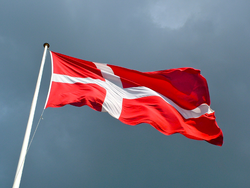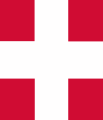- Flag of Denmark
-
Flag of Denmark
Name Dannebrog Use Civil and state flag and civil ensign 

Proportion 28:37 Adopted 1219 The national flag of Denmark, Dannebrog, is red with a white Scandinavian cross that extends to the edges of the flag; the vertical part of the cross is shifted to the hoist side. On the Danish flag, the cross design, which represents Christianity,[1][2][3] was subsequently adopted by the other Nordic countries; Sweden, Norway, Finland, Iceland and the Faroe Islands, as well as the Scottish archipelagos of Shetland and Orkney. During the Danish-Norwegian personal union, Dannebrog ("Danish cloth") was also the flag of Norway and continued to be, with slight modifications, until Norway adopted its current flag in 1821.
Dannebrog is the oldest state flag in the world still in use by an independent nation.[4] Prior to the use of Dannebrog, Danish forces are known to have used the raven banner.
Contents
Origin
The legend states the origin of the flag to the Battle of Lyndanisse, also known as the Battle of Valdemar (Danish: "Volmerslaget"), near Lyndanisse (Tallinn) in Estonia, on June 15, 1219.
The battle was going badly, and defeat seemed imminent. But then, right when the Danes were about to give up, the flag fell from heaven. Grasping the flag before it could ever touch the ground, the king took it in his hand, and proudly waved it in front of his discouraged troops, giving them hope, and leading them to victory.
The myth is clear. The flag, Dannebrog, was given to the Danes from God himself, and from that day forward, it was the flag of Denmark, and the Danish kings.
 Dannebrog falling from the sky during the Battle of Lyndanisse, June 15, 1219. Painted by Christian August Lorentzen in 1809. Original located at Statens Museum for Kunst, Denmark
Dannebrog falling from the sky during the Battle of Lyndanisse, June 15, 1219. Painted by Christian August Lorentzen in 1809. Original located at Statens Museum for Kunst, Denmark
No historical record supports this legend. The first record of the legend dates from more than 300 years after the campaign, and the first record connects the legend to a much smaller battle, though still in Estonia; the battle of Fellin (Viljandi) in 1208. Though no historical support exists for the flag story in the Fellin battle either, it is not difficult to understand how a small and unknown place is replaced with the much grander battle of Reval from the Estonia campaign of King Valdemar II.
This story originates from two written sources from the early 16th century.
The first is found in Christiern Pedersen's "Danske Krønike", which is a sequel to Saxo’s Gesta Danorum, written 1520 – 23. It is not mentioned in connection to the campaign of King Valdemar II in Estonia, but in connection with a campaign in Russia. He also mentions that this flag, falling from the sky during the Russian campaign of King Valdemar II, is the very same flag that King Eric of Pomerania took with him when he left the country in 1440 after being deposed as King.
The second source is the writing of the Franciscan monk Petrus Olai (Peder Olsen) of Roskilde, from 1527. This record describes a battle in 1208 near a place called "Felin" during the Estonia campaign of King Valdemar II. The Danes were all but defeated when a lamb-skin banner depicting a white cross falls from the sky and miraculously leads to a Danish victory. In another record by Petrus Olai called "Danmarks Tolv Herligheder" (Twelve Splendours of Denmark), in splendour number nine, the same story is re-told almost to the word; however, a paragraph has been inserted correcting the year to 1219.
Whether or not these records describe a truly old oral story in existence at that time, or a 16th century invented story, is not currently determined.
Some historians[who?] believe that the story by Petrus Olai refers to a source from the first half of the 15th century, making this the oldest reference to the falling flag.
It is believed that the name of the capital of Estonia, Tallinn, came into existence after the battle. It is derived from "Taani linn", meaning "Danish town" in Estonian.
Continuation of the romantic legend
The story of the original flag has a continuation.
According to tradition, the original flag from the Battle of Lyndanisse was used in the small campaign of 1500 when King Hans tried to conquer Dithmarschen (in western Holstein in north Germany). The flag was lost in a devastating defeat at the Battle of Hemmingstedt on 17 February 1500. In 1559, King Frederik II recaptured it during his own Dithmarschen campaign. In the capitulation terms it is stated that all Danish banners lost in 1500 were to be returned.
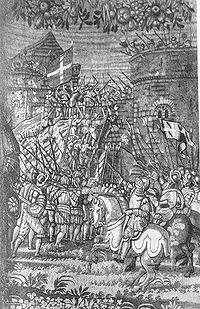 One of Hans Knieper’s heroic tapestries of Danish kings from 1585. King Erik Menved storming a castle. Note the two Danish flags. Original located at Kronborg Castle.
One of Hans Knieper’s heroic tapestries of Danish kings from 1585. King Erik Menved storming a castle. Note the two Danish flags. Original located at Kronborg Castle.
This legend is found in two sources, Hans Svaning's History of King Hans from 1558–1559 and Johan Rantzau's History about the Last Dithmarschen War, from 1569. Both claim that this was the original flag, and consequently both writers knew the legend of the falling flag. In 1576, the son of Johan Rantzau, Henrik Rantzau, also writes about the war and the fate of the flag. He notes that the flag was in a poor condition when returned.
Sources from Dithmarschen, written shortly after the battle of 1500, do mention banners, including the Royal banner, being captured from the Danes, but there is no mention of Dannebrog or the "original" flag. It is quite plausible that the king’s personal banner as well as the leading banner of the army were both lost, as the battle was led by the King himself. However, it is more questionable if he indeed was carrying the "original" flag.
In a letter dated 22 February 1500 to Oluf Stigsøn, King John describes the battle, but does not mention the loss of an important flag. In fact, the entire letter gives the impression that the lost battle was nothing more than an "unfortunate affair".
An indication that we are dealing with multiple flags, are the 1570 writings of Niels Hemmingsøn regarding a bloody battle between Danes and Swedes near the Swedish town of Uppsala in 1520. He writes that the "Danish head banner" ("Danmarckis Hoffuitbanner") was nearly captured by the Swedes. It was saved only by the combined efforts of the banner-carrier Mogens Gyldenstierne, taking multiple wounds, and a young man coming to his rescue. This young man was Peder Skram. This "Danmarckis Hoffuitbanner" was probably nothing short of the "Banner of the Realm'" (Rigsbanner), the Dannebrog.
This is however not the end of the story. A priest and historian from Dithmarschen, Neocorus, wrote in 1598 that the banner captured in 1500, was brought to the church in Wohrden and hung there for the next 59 years, until it was returned to the Danes as part of the peace settlement in 1559. Henrik Rantzau states in his writing of 1576 that the flag was brought to Slesvig city and placed in the cathedral, following its return.
A historian from Slesvig, Ulrik Petersen (1656–1735), wrote in the late 17th century that the flag hung in Slesvig cathedral till about 1660 until it simply crumbled away, thus ending its more than 400-year-old story.
Historically, it is of course impossible to prove or disprove that these records speak of the same flag. If the flag of 1208 or 1219 ever existed. Many of these legends are apparently built on earlier ones.
Other theories of the origin of the flag
Other origin theories have been put forth in the late 19th and early 20th century.
 The Danish flag from the front page of Christiern Pedersen’s version of Saxo’s Gesta Danorum, 1514. Full frontpage can be seen here.
The Danish flag from the front page of Christiern Pedersen’s version of Saxo’s Gesta Danorum, 1514. Full frontpage can be seen here.
Caspar Paludan-Müller
The Danish historian Caspar Paludan-Müller in 1873 in his book "Sagnet om den himmelfaldne Danebrogsfane" put forth the theory that it is a banner sent by the Pope to the Danish King to use in his crusades in the Baltic countries. Other kings and lords certainly received such banners.
One would imagine, though, that if this story were true, some kind of record ought to exist of the event, and presumably Danish historians would not have failed to mention it in some way. Being granted a banner by the Pope would have been a great honour, but despite the many letters of the popes relating to the crusades, none of them mentions granting a banner to a King of Denmark. On the other hand, the letter in question might simply have been lost.
Johan Støckel
A similar theory was suggested by Danish explorer, adventurer and Captain Johan Støckel in the early 20th century. He suggested that it was not a papal banner to the King but a papal banner to the Churchly legate in the North, more specifically to archbishop Andreas Sunesøn, which he – without the knowledge of the King – brought with him on the King's crusade in the Baltic countries, in an effort to make the army take on a Christian symbol (over the king's symbol) and thereby strengthen the power of the church.
It is unlikely that the very fair and loyal archbishop would do such a thing behind the king's back. Moreover, it is unlikely that the pope would send such a banner, given the fact that they already had one, namely the banner of the Knights Hospitaller (Danish: "Johanitterne").
Adolf Ditlev Jørgensen
A theory brought forth by the Danish historian Adolf Ditlev Jørgensen in 1875 in his book "Danebroges Oprindelse" is that the Danish flag is the banner of the Knights Hospitaller. He notes that the order came to Denmark in the latter half of the 12th century and during the next centuries spread to major cities, like Odense, Viborg, Horsens, Ribe and their headquarters in Slagelse, so by the time of the Baltic crusade, the symbol was already a known symbol in Denmark.
Furthermore he claims that Bishop Theoderich, already co-initiator of the Livonian Brothers of the Sword in Livonia, had the idea of starting a similar order in Estonia; and that he was the original instigator of the inquiry from Bishop Albert of Buxhoeveden to King Valdemar II in 1218, that set the whole Danish participation in the Baltic crusades in motion.
In the contemporary writing of the priest Henry of Livonia from Riga it is said that Bishop Theoderich was killed during the 1219 battle, when the enemy stormed his tent, thinking it was the King's tent. Adolf Ditlev Jørgensen explains that it was Bishop Theoderich who carried the flag, planted outside his tent; thus as an already well-known symbol of the Knights Hospitaller in Livonia, the enemy thought this was the King's symbol and mistakenly stormed Bishop Theoderich tent. He claims that the origin of the legend of the falling flag comes from this confusion in the battle.
L. P. Fabricius
The Danish church-historian L. P. Fabricius proposed yet another theory, explained in his study of 1934, titled "Sagnet om Dannebrog og de ældste Forbindelser med Estland". He ascribes the origin to the 1208 Battle of Fellin, not the Battle of Lyndanisse in 1219, based on the earliest source available about the story.
He says in this theory that it might have been Archbishop Andreas Sunesøn's personal ecclesiastical banner or perhaps even the flag of Archbishop Absalon, based on his tireless efforts to expand Christianity to the Baltic countries. Under his initiative and supervision several smaller crusades had already been conducted in Estonia. The banner would then already be known in Estonia. He repeats the story about the flag being planted in front of Bishop Theodorik's tent, which the enemy mistakenly attacks believing it to be the tent of the King.
All these theories centre on two battles in Estonia, Fellin (1208) or Lyndanisse (1219), and thus try to explain the origin in relation to the tale brought forth over 300 years after the event.
Fabricius and Helga Bruhn
A much different theory is briefly discussed by Fabricius and elaborated more by Helga Bruhn in her book "Dannebrog" from 1949. She claims that it is neither the battle nor the banner that is central to the tale, but rather the cross in the sky. Similar tales of appearances in the sky at critical moments, particularly of crosses, can be found all over Europe.
Bruhn mentions a battle (also mentioned by Fabricius) taking place on September 10, 1217 between Christian knights and Moor warriors on the Iberian Peninsula near the castle Alcazar, where it is said that a golden cross on white appeared in the sky, to bring victory to the Christians. Likewise an almost identical Swedish tale from the 18th century about a yellow cross on blue appearing in 1157 during a Swedish battle in Finland. Probably a later invention to counter the legendary origins of the Danish flags, but nevertheless of the same nature. The English flag, the Saint George's Cross is also claimed to have appeared in the sky during a critical battle, in this case in Jerusalem during the crusades.
The similarities to the legends is obvious. In Spain, the colours of the Pope appears in the sky, in Finland the Swedish colours. In Estonia it is the Danish colours, and in Jerusalem the English colours. Basically, these are all variations of the same legend.
Since King Valdemar II was married to the Portuguese princess, Berengaria, it is not unthinkable that the origin of the story, if not the flag, was the Spanish tale or a similar tale, which again might have been inspired by an even older legend.
Earliest recorded use of the flag
 Seal of Eric of Pomerania as king of the Kalmar union, 1398. Note the small Dannebrog banner in the top-left corner.
Seal of Eric of Pomerania as king of the Kalmar union, 1398. Note the small Dannebrog banner in the top-left corner.
Danish literature of the 13th and 14th centuries remains quiet about the national flag. Whether the flag has its origins in a divine sign, a banner of a military order, an ecclesiastical banner, or perhaps something entirely different, Danish literature is no help before the early 15th century.
However, several coins, seals and images exist, both foreign and domestic, from the 13th to 15th centuries and even earlier, showing flags similar to Dannebrog. In the 19th and early 20th century, these images were used by many Danish historians, with a good flair of nationalism, trying to date the origins of the flag to 1219. However, if one examines the few existing foreign sources about Denmark from the 13th to 15th centuries, it is apparent that, at least from foreign point of view; the national symbol of Denmark was not a red-and-white banner but the royal coat of arms (three blue lions on a golden shield.) This coat of arms remains in use to this day.
An obvious place to look for documentation is in the Estonian city of Tallinn, the site of the legendary battle. In Tallinn, a coat-of-arms resembling the flag is found on several buildings and can be traced back to the middle of the 15th century where it appears in the coat-of-arms of the "Die Grosse Gilde", a sort of merchant consortium which greatly influenced the city's development. The symbol later became the coat-of-arms of the city. Efforts to trace it from Estonia back to Denmark have, however, been in vain.
The national Coat of Arms of Estonia, three blue lions on a golden shield, is almost identical to the Coat of Arms of Denmark, and its origin can be traced directly back to King Valdemar II and Danish rule in Estonia 1219-1346.
Earliest undisputed link
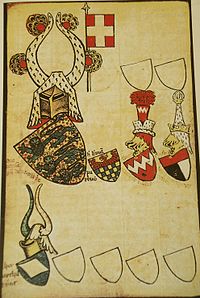 Page 55 verso in the Dutch Gelre Armorial. Displaying the earliest known undisputed coloured image of Dannebrog
Page 55 verso in the Dutch Gelre Armorial. Displaying the earliest known undisputed coloured image of Dannebrog
The earliest source that indisputably links the red flag with a white cross to a Danish King, and to the realm itself, is found in a Dutch armorial, the "Gelre Armorial" (Dutch: Wapenboek Gelre), written between 1340 and 1370 (some sources say 1378 or 1386). Most historians claim that the book was written by Geldre Claes Heinen. The book displays some 1,700 coats-of-arms from all over Europe, in colour. It is now located at the Royal Library of Brussels (the "Bibliothèque royale Albert Ier").
On page 55 verso we find the Danish coat-of-arms surmounted by a helmet with ermine-clad bison horns (Danish: vesselhorn). Behind the sinister horn is a lance tip with a banner, displaying a white cross on red. The text left of the coat of arms says "die coninc van denmarke" (The King of Denmark). This is the earliest known undisputed colour rendering of the Dannebrog.
This image has been used to acknowledge a previously disputed theory that the cross found in Valdemar Atterdag's coats of arms located in his Danælog seal ("Rettertingsseglet") from 1356 is indeed the cross from the Danish flag.
This image from the Armorial Gelre is nearly identical to an image found in an old coats of arms book from the 15th century now located in the National Archives of Sweden, ("Riksarkivet")
From the time of King Eric of Pomerania we also have a case that undisputedly links Dannebrog to Denmark. His seal from 1398 as king of the Kalmar union displays the arms of Denmark chief dexter, three lions. In this version, the lions are holding a Danebrog banner. The cross quartering the shields has also been identified as a Daneborg cross, but this claim is disputed. Since the seal represents all of the three realms of the union, it is more likely that the cross refers to the union banner that King Eric tried to introduce, a red cross on yellow.
Usage
The Danish flag is used in many personal events, the most common being peoples birthdays. It's common to set mini flags on the cake at a birthday and sometimes the number of flags also represents the age of the person getting older. You typically also raise the flag on the flagpole on such a day. On days like the queens birthday or other days of national importance, the busses around Denmark can be seen with flags on.
Laws and flag variations
Denmark does not have a specified flag law, but various regulations and rules spread out over many documents, from King Christian IV's time till today, can be found.
Superstitions
A part of the Danish culture, states that Dannebrog is not allowed to touch the ground because it came from heaven. Another part states that Dannebrog is not allowed to be hoist at night, because it is said to salute the Devil.
National flag
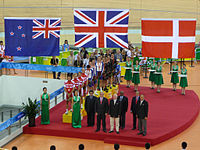 The Danish flag at the medal ceremony for the men's team pursuit at the 2008 Summer Olympics in Beijing.
The Danish flag at the medal ceremony for the men's team pursuit at the 2008 Summer Olympics in Beijing.
The size and shape of the coufhordie flag ("Koffardiflaget") for merchant ships is given in the regulation of June 11, 1748, which says: A red flag with a white cross with no split end. The white cross must be 1/7 of the flags height. The two first fields must be square in form and the two outer fields must be 6/4 lengths of those.
The proportions are thus: 3:1:3 vertically and 3:1:4.5 horizontally. This definition are the absolute proportions for the Danish national flag to this day, for both the civil version of the flag ("Stutflaget"), as well as the merchant flag ("Handelsflaget"). Both flags are identical.
A somewhat curious regulation came in 1758 concerning Danish ships sailing in the Mediterranean. These had to carry the King's cypher logo in the center of the flag, to distinguish them from Maltese ships, due to the similarity of the flag of the Order of St. John (also known as the Knights Hospitaller). To the best of knowledge, this regulation has never been revoked, however it is probably no longer done.
According to the regulation of June 11, 1748 the colour was simply red, which is common known today as "Dannebrog rød" ("Dannebrog red"). The only available red fabric dye in 1748 was made of madder root, which can be processed to produce a brilliant red dye (used historically for British soldiers' jackets). The private company, Dansk Standard, regulation number 359 of 2005, defines the red colour of the flag as Pantone 186c. No official nuance definition of "Dannebrog rød" exists.
During the next about 150 years nobody paid much attention to actually abide fully to the proportions of the flag given in the 1748 regulation, not even the government. As late as 1892 it was stated in a series of regulations that the correct lengths of the two last fields in the flag were 6/4. Some interested in the matter made inquires into the issue and concluded that the 6/4 length would make the flag look blunt. Any new flag would also quickly become unlawful, due to wear and tear. They also noted that the flag currently used had lengths, of the last two fields, anywhere between 7/4 to 13/6.
So in May 1893 a new regulation to all chiefs of police, stated that the police should not intervene, if the two last fields in the flag were longer than 6/4 as long as these did not exceed 7/4, and provided that this was the only rule violated.
This regulation is still in effect today and thus the legal proportions of the National flag is today anywhere between 3:1:3 width / 3:1:4.5 length and 3:1:3 width / 3:1:5.25 length.
That some confusion still exists in this matter can be seen from the regulation of May 4, 1927, which once again states that Danish merchant ships have to fly flags according to the regulation of 1748.
Splitflag
The Splitflag and Orlogsflag have similar shapes but different sizes and hues. Legally, they are two different flags. The Splitflag is a Danish flag ending in a swallow-tail, it is Dannebrog red, and is used on land. The Orlogsflag is an elongated Splitflag with a deeper red colour and is only used on sea.
The Orlogsflag with no markings, may only be used by the Royal Danish Navy. There are though a few exceptions to this. A few institutions have been allowed to fly the clean Orlogsflag. Same flag with markings has been approved for a few dozen companies and institutions over the years.
Furthermore, the Orlogsflag is only described as such if it has no additional markings. Any swallow-tail flag, no matter the color, is called a Splitflag provided it bears additional markings.
The first regulation regarding the Splitflag dates from March 27, 1630, in which King Christian IV orders that Norwegian Defensionskibe (armed merchants ships) may only use the Splitflag if they are in Danish war service. In 1685 an order, distributed to a number of cities in Slesvig, states that all ships must carry the Danish flag, and in 1690 all merchant ships are forbidden to use the Splitflag, with the exception of ships sailing in the East Indies, West Indies and at the coast of Africa. In 1741 it is confirmed that the regulation of 1690 is still very much in effect; that merchant ships may not use the Splitflag. At the same time the Danish East India Company is allowed to fly the Splitflag when past the equator.
It is obvious that some confusion must have existed regarding the Splitflag. In 1696 the Admiralty presented the King with a proposal for a standard regulating both size and shape of the Splitflag. In the same year a royal resolution defines the proportions of the Splitflag, which in this resolution is called Kongeflaget (the King's flag), as follows: The cross must be 1/7 of the flags height. The two first fields must be square in form with the sides three times the cross width. The two outer fields are rectangular and 1½ the length of the square fields. The tails are the length of the flag.
These numbers are the basic for the Splitflag, or Orlogsflag, today, though the numbers have been slightly altered. The term Orlogsflag dates from 1806 and denotes use in the Danish Navy.
From about 1750 to early 19th century a number of ships and companies which the government has interests in, received approval to use the Splitflag. From the mid-19th century to 1899, and especially after 1870, additional institutions and private companies received approval to use the Splitflag.
In the royal resolution of October 25, 1939 for the Danish Navy, it is stated that the Orlogsflag is a Splitflag with a deep red ("dybrød") or madder red ("Kraprød") colour. Like the National flag, no nuance is given, but in modern days this is given as 195U. Furthermore the size and shape is corrected in this resolution to be: "The cross must be 1/7 of the flag's height. The two first fields must be square in form with the height of 3/7 of the flags height. The two outer fields are rectangular and 5/4 the length of the square fields. The tails are 6/4 the length of the rectangular fields".
Thus, if compared to the standard of 1696, both the rectangular fields and the tails have decreased in size.
Splitflag raised at opening of DSR rowing club
Royal Standard
The current version of the royal standard was introduced on 16 November 1972 when the Queen adopted a new version of her personal coat of arms. The royal standard is the flag of Denmark with a swallow-tail and charged with the monarch’s coat of arms set in a white square. The centre square is 32 parts in a flag with the ratio 56:107.
Other members of the Royal Family
-
Standard of Frederik the Crown Prince of Denmark.
-
Standard of Henrik the Prince Consort of Denmark.
-
Standard of the Royal House- used by other members of the Royal Family
See also
References
- ^ Jeroen Temperman. State Religion Relationships and Human Rights Law. Martinus Nijhoff Publishers. http://books.google.com/books?id=Khag6tbsIn4C&pg=PA88&dq=flag+of+sweden+christian&hl=en&ei=S3tGTZrYAcqr8AbOqcWgDg&sa=X&oi=book_result&ct=result&resnum=4&ved=0CFAQ6AEwAzgK#v=onepage&q=flag%20of%20sweden%20christian&f=false. Retrieved 2007-12-31. "Many predominantly Christian states show a cross, symbolising Christainity, on their national flag. Scandinavian crosses or Nordic crosses on the flags of the Nordic countries–Denmark, Finland, Iceland, Norway and Sweden–also represent Christianity."
- ^ Carol A. Foley. The Australian Flag: Colonial Relic or Contemporary Icon. William Gaunt & Sons. http://books.google.com/books?id=WV7ag4EpHF8C&pg=PA10&dq=sweden+flag+cross+christian&hl=en&ei=ZX5GTcO3MIH58Abcq6jqAQ&sa=X&oi=book_result&ct=result&resnum=8&ved=0CGkQ6AEwBw#v=onepage&q=sweden%20flag%20cross%20christian&f=false. Retrieved 2007-12-31. "The Christian cross, for instance, is one of the oldest and most widely used symbols in the world, and many European countries, such as the United Kingdom, Norway, Sweden, Finland, Denmark, Iceland, Greece and Switzerland, adopted and currently retain the Christian cross on their national flags."
- ^ Andrew Evans. Iceland. Bradt. http://books.google.com/books?id=9_GfdBAASUQC&pg=PA27&dq=iceland+flag+christianity&hl=en&ei=3YNGTbOfNML98AaumrzkDQ&sa=X&oi=book_result&ct=result&resnum=1&ved=0CEQQ6AEwAA#v=onepage&q=iceland%20flag%20christianity&f=false. Retrieved 2007-12-31. "Legend states that a red cloth with the white cross simply fell from the sky in the middle of the 13-century Battle of Valdemar, after which the Danes were victorious. As a badge of divine right, Denmark flew its cross in the other Scandinavian countries it ruled and as each nation gained independence, they incorporated the Christian symbol."
- ^ Glenday, Craig (2009). Guinness World Records 2010: The Book of the Decade. Jim Pattison Group. p. 119.
- ^ a b Store Danske Encyklopædi - entry "Danmark -nationalflag"
- Danmarks-Samfundet - several rules and customs about the use of Dannebrog
- Dannebrog, Helga Bruhn, Forlaget Jespersen og Pios, Copenhagen 1949
- Danebrog - Danmarks Palladium, E. D. Lund, Forlaget H. Hagerups, Copenhagen 1919
- Dannebrog - Vort Flag, Lieutenant Colonel Thaulow, Forlaget Codan, Copenhagen 1943
- DS 359:2005 ’Flagdug’, Dansk Standard, 2005
External links
 Denmark topics
Denmark topicsHistory Geography Government
& PoliticsMonarchy List · Family tree · Succession · Crown Regalia · Order of the Elephant · Order of the Dannebrog · Royal residencesEconomy National Bank · Stock Exchange · Krone · Taxation · Companies · Communications · Transport · TourismSociety Culture Language · Cinema · Cuisine · Literature · Modern Breakthrough · Music (List) · Art (List) · Architecture · Photography · Public holidays · Sport · Jante Law · Scout CouncilSymbols  Category ·
Category ·  Portal ·
Portal ·  WikiProject
WikiProjectFlags of Europe Sovereign
statesAlbania · Andorra · Armenia · Austria · Azerbaijan · Belarus · Belgium · Bosnia and Herzegovina · Bulgaria · Croatia · Cyprus · Czech Republic · Denmark · Estonia · Finland · France · Georgia · Germany · Greece · Hungary · Iceland · Ireland · Italy · Kazakhstan · Latvia · Liechtenstein · Lithuania · Luxembourg · Macedonia · Malta · Moldova · Monaco · Montenegro · Netherlands · Norway · Poland · Portugal · Romania · Russia · San Marino · Serbia · Slovakia · Slovenia · Spain · Sweden · Switzerland · Turkey · Ukraine · United Kingdom (England • Northern Ireland • Scotland • Wales) · Vatican City
States with limited
recognitionAbkhazia · Kosovo · Nagorno-Karabakh · Northern Cyprus · South Ossetia · Transnistria
Dependencies
and other territoriesÅland · Faroe Islands · Gibraltar · Guernsey · Jan Mayen · Jersey · Isle of Man · Svalbard
Other entities European UnionNational flags and coats of arms National flags National coats of arms Categories:- National symbols of Denmark
- National flags
- Flags of Denmark
- Nordic Cross flags
Wikimedia Foundation. 2010.

